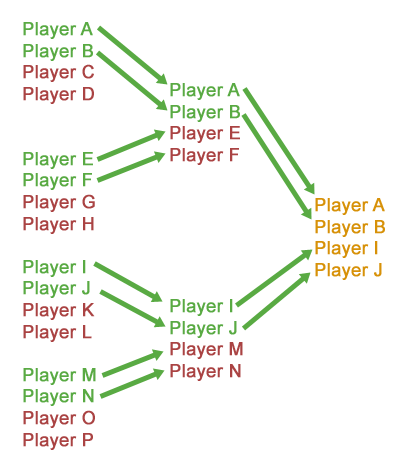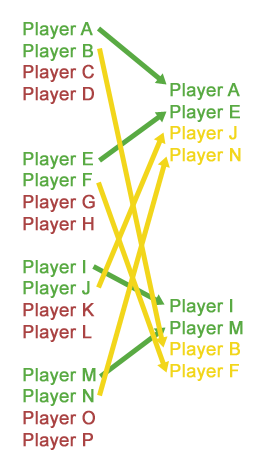The Art of Over-Thinking Tournament Formats
By trace 10 Comments
I think about strange, middling things, perhaps at too much length. For the heck of it, I figured I'd describe my recent thought process for one such thing here. At the very least, that should help establish a permanent record of my thoughts in the event I forget about this whole ordeal a few months down the road.
Trials Evolution is coming out this Wednesday. I played it at PAX East alongside other Giant Bomb mods and users, and it's a lot of fun. Trials can be frustrating as hell alone, but the four-lane supercross multiplayer, which puts more emphasis on racing and basic technique, eschews most of the frustration for hectic speed. I entertained the idea of hosting site-wide online tournaments here on Giant Bomb, and the second I did, my mind began racing over how brackets would work.
Most tournament brackets are focused on head-to-head matchups, be it team versus team or player versus player. The methods for handling these are numerous and well-established, both for single elimination and double elimination. Four competitors at once, however, is a trickier format, and while you can simplify it somewhat, that can be to the detriment of the ongoing competition.
Let me explain by highlighting the various formats and quirks I've been thinking about in regards to a Giant Bomb Trials Evolution supercross tournament. I'll use my own naming conventions, since I haven't found much in the way of information elsewhere.
Half In/Transfer
This is a more basic, straightforward format, and I'd expect most people would use this when faced with a similar style of tournament. It's much like you might see in a snowboard cross tournament at the Olympics or the X-Games: There's a set amount of transfer spots in each round, and a competitor either finishes well enough to transfer or is eliminated. Typically, you'd transfer the top two finishers in a four-person heat, which is pretty standard. This was also the format of tournaments in Forza Motorsport 2, except those matches had eight racers and transferred the top four to the next round.
It's an easy format to follow, both in the layout of the brackets and knowing how you have to perform in each match. It's also really simple for drawing up brackets as an organizer, which is helpful when you have an odd amount of entrants and need to figure out where your play-in matches or preliminaries need to go. However, it doesn't provide any extra incentive to be first until the very final round, since you're only looking to transfer as one of the top two. There's also no chance to recover from a single bad performance, so slipping up and finishing third means elimination at any point, even if it's after a string of firsts.
The other quirk here that can be dealt with involves seeding as rounds progress. In most formal tournaments, the transferring competitors move along the brackets much as if the tournament was geared for head-to-head matches. This means that if the same pair of competitors keep finishing in the transfer spots in each round, they could conceivably be facing off against each other for the entirety of the tournament.

This is where a little mixing or re-seeding can help out a less formal tournament. Perhaps I instead move all the second place finishers into another bracket to face another set of first place finishers. This hampers some of the ease of following the brackets, but it allows players to face a wider variety of opponents over their time in the tournament. Plus, having a more predictable movement along the brackets could be an incentive for finishing in first, I suppose.

This mixed "half in" format will probably be what I use for any Trials Evolution tournaments on Giant Bomb. What if I wanted to allow competitors more chances to recover and redeem themselves, though, sort of in the vein of double elimination (but not quite)? There's a complicated format for that, too.
Last Chance Qualifiers
In motocross and a lot of short track dirt racing, every heat sends a set amount of people to the main race, or at least to the next round. At least a portion of the entrants that didn't transfer then fight for a smaller handful of remaining spots in the main race, in what's called a "Last Chance Qualifier" heat. It's essentially your last chance of the night to get into the big money race, and while the chances are slim, it's at least a chance, which can be handy if you experienced misfortune in your earlier heat race.
This could be implemented into bracketed tournaments, as well, and it's actually beneficial on a few fronts. It allows for multiple chances to move forward in a tournament, while providing more incentive to finish in better positions to avoid having to compete in additional matches. It also provides a lot more matches for competitors to participate in, and generally provides a better sense of overall ranking against everyone else at the end of a tournament.
Of course, the problem is that it's difficult to organize, difficult to follow, and the method of providing multiple chances to move on, since it's not exactly double elimination style or otherwise strictly defined, can appear arbitrary in its implementation.
This LCQ format I've thought up also takes a lot more matches in general. For sixteen entrants, I could put together a tournament in the LCQ format that takes twelve to fifteen matches to run, whereas a typical transfer/half in system could handle double that, with thirty-two entrants in fifteen matches. It's not efficient, but that's not really the point -- it's meant to be exciting for someone watching the tournament unfold. Then again, that implies somebody other than the entrants will be watching a tournament like this unfold, and is that really going to happen for something this minor? Probably not.
Anyways, that's just a little bit of the thought process going through my head for potential Trials Evolution tournaments. I kind of wish there were more resources out there for tournaments that involve matches more complex than head-to-head, so that this sort of shindig would be easier to plan and implement.
